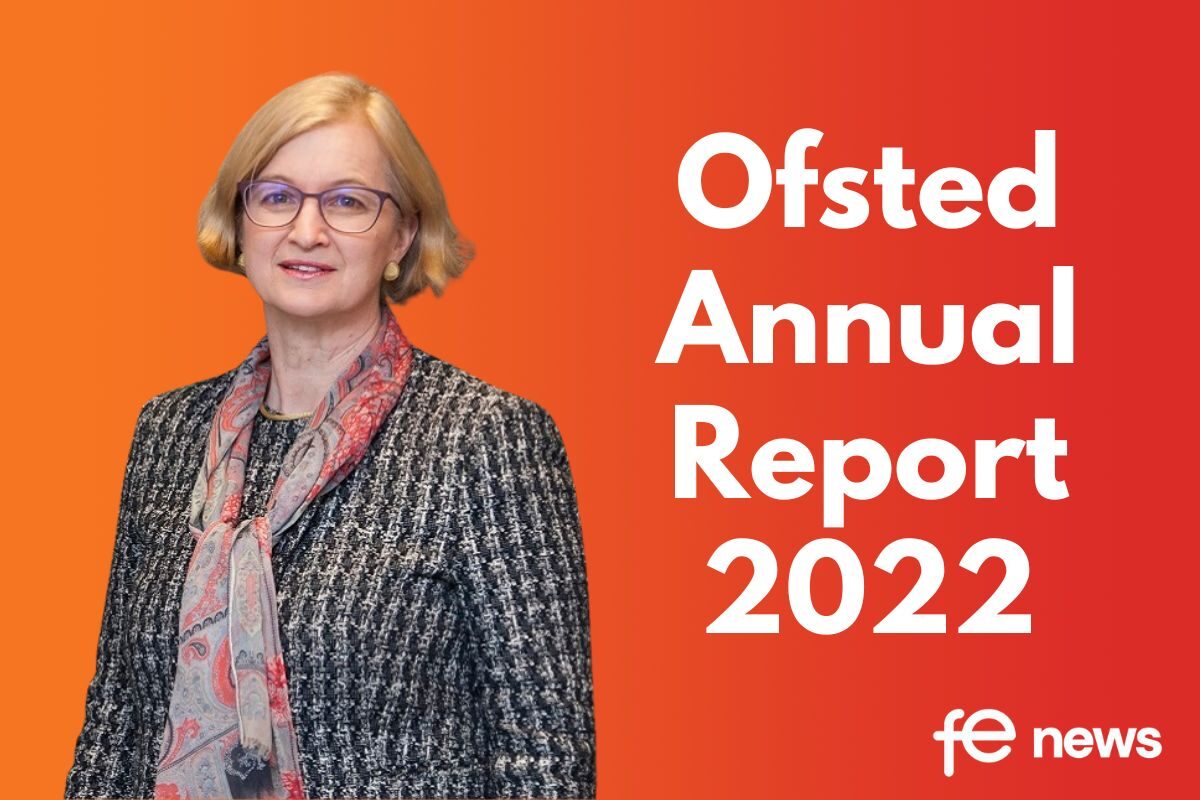Ofsted Annual Report 2022

Ofsted Annual Report 2022: Pandemic recovery slowed by workforce crisis in children’s education and care
The report highlights some shocking stats on Prison Education, and even equipping inmates to read and a lack of direction and CPD for Skills Bootcamp Providers.
- 82% of further education providers are currently judged good or outstanding, the same as last year. However, the proportion of colleges judged good or outstanding has increased by 11 percentage points to 91%.
- Staff shortages compounding difficulties in education and social care
- Children have lacked stability and security in recent years – staffing problems continue to affect their experience
This year’s Ofsted Annual Report describes the extent to which education and children’s social care have recovered in the wake of the pandemic. It finds that, while there is much to be commended, ensuring this generation of children and young people get the education, training, care and opportunities they deserve remains a work in progress.
The report looks back at the last academic year, from September 2021 to August this year. When it began, education and social care providers were still dealing with the pandemic’s very recent aftermath. As it closed, the energy crisis and cost of living pressures were starting to bite, making life harder for the education and social care sectors and testing the resilience of both.
The report highlights a number of issues in education and care that are either created or exacerbated by workforce and resourcing challenges, and which are compounding problems left over from the pandemic. Children are bearing the brunt of these issues, as staff shortages create problems that can affect their quality of education and care.
If the education and social care sectors are to be resilient in the face of future challenges, problems recruiting and retaining staff must be urgently addressed:
- The early years sector is competing with, and losing out to, higher paid or more flexible employment. Nurseries have closed because they cannot recruit or retain high-quality, qualified and experienced staff. Some have become over-reliant on apprentices to fill gaps, which has a knock-on effect on the quality of education and safeguarding.
- Long-standing staffing challenges in the social care sector have worsened. Children’s homes are losing care workers to retail or hospitality – or another home that pays more – and the number of foster carers has fallen to its lowest point in years. This means there may not be enough places for children to live, or enough staff with the necessary skills to care for them.
- Staffing issues mean local authorities are increasingly reliant on agency social workers, whose terms often include more remote working. This can affect the quality of their relationships with children, as well as their level of local knowledge. Increasing workloads for those staying in the sector can also make the demands of an already challenging job unsustainable.
- High staff turnover creates instability for children in care, as it reduces their chances to build relationships, which are important for their well-being and sense of security.
- Recruitment continues to be a frustration for schools, colleges and independent learning providers. Schools report shortages of teaching assistants, and colleges are finding it difficult to recruit tutors in many areas. Fewer college staff can result in larger class sizes of mixed abilities, which can make it difficult to pitch the education or training at the right level.
- Schools have also continued to experience COVID-related staff absences. High demand makes it difficult to recruit supply teachers, so many schools have used their own staff to cover absences, which increases workloads. Managing with fewer staff slows the pace of intervention when children need extra help. And it has delayed the return of sports, drama, music and other enrichment activities that are normally part of the school experience.
- Many schools have found it difficult to access external support services for pupils with mental health issues. Lengthy waiting lists have placed an extra burden on schools.
- In some special (and mainstream) schools, recruiting staff with SEND expertise has been difficult, and staff turnover has been higher than pre-pandemic. As a result, children’s individual needs are not always met.
His Majesty’s Chief Inspector, Amanda Spielman, said:
“The pandemic continued to cast a shadow over education and children’s social care for much of the past year. And the energy crisis and economic pressures have brought more turbulence in recent months. So I would like to record my thanks to everyone working in education and care for their efforts in what was clearly another very difficult year.
“Across all age groups in education, careful thought has been given to making up lost learning. However, achievement gaps are still wider than before the pandemic, meaning the recovery is far from complete. And it’s clear that in education – and in children’s social care – staffing issues are compounding problems standing in the way of a full recovery.
“We owe the current generation of young people as much security and certainty as we can provide for what remains of their childhood. And we must offer them the education, training and opportunities they need to secure their future. To do that, it’s vital that education and social care providers are able to recruit, train and retain talented and capable people.”
Ofsted activity across FE in 2022:
In 2021/22, we carried out just over 500 inspections and 220 monitoring visits:
● 330 full inspections of providers that had not previously had a full inspection, of which 65% were judged good or outstanding
● 34 full inspections of providers that were previously judged outstanding; of these, 14 remained outstanding, 17 were judged good and three were judged requires improvement
● 49 full inspections of providers that were previously judged good; of these, 38 remained good, eight declined to requires improvement and three declined to inadequate
● 79 full inspections of providers that were previously judged requires improvement, of which 62% improved to good or outstanding
● six full inspections of providers that were previously judged inadequate, of which four improved to good, one improved to requires improvement and one remained inadequate
● 12 short inspections of providers that were previously judged good and remained good
● one short inspection that was extended to a full inspection and the provider declined to inadequate.
Overall, of 500 full inspections carried out this year, 67% resulted in an overall judgement of good or outstanding.
All providers judged good or outstanding overall were also judged good or outstanding for quality of education. Sixty-seven per cent of providers were judged good or outstanding for leadership and management, 68% for quality of education, 71% for personal development and 85% for behaviour and attitudes. The relationship between the key judgements and overall effectiveness is similar to that seen in previous years, with a higher proportion of providers judged good or outstanding for behaviour and attitudes than for overall effectiveness.
Providers at their first full inspection Outcomes from first inspections
Providers at their first full inspection Outcomes from first inspections have continued to improve since 2017/18. Of the 330 providers that received a first full inspection this year, 65% were judged good or outstanding (190 good and 20 outstanding). This was an increase of 14 percentage points compared with the 2018/19 reporting year. This improvement should be understood in the context of the new provider monitoring visits we introduced in early 2018. These have flagged progress and areas for improvement to providers. The Education and Skills Funding Agency and other regulatory bodies have also taken steps to improve the quality of providers. For example, they have introduced the register of apprenticeship training providers and other quality management processes. Finally, the successive improvements are down to the efforts of providers themselves.
Common themes identified in inspection reports of providers judged outstanding were:
● leaders ensured that the curriculum was ambitious, challenging and varied, and gave learners the opportunity and aspiration to excel
● tutors knew their learners well, challenged them and gave them useful feedback
● learners were inspired and motivated and took responsibility for their own learning
● learners worked towards ambitious targets that motivated them to make good progress and prepared them well for their future career
● leaders worked effectively with the community and employers to ensure their curriculum met market needs
Inspections of previously exempt providers
This year we prioritised inspections of providers that had gone longest without inspection. These providers were previously exempt because they had been judged outstanding at their previous inspection. This year, we inspected 31 formerly exempt providers: 14 were judged outstanding, 14 were judged good and three were judged requires improvement. Most had not been inspected for over 10 years, and all were previously inspected under superseded inspection frameworks. Common themes identified in inspection reports as areas for improvement were:
● leaders should ensure the curriculum is planned effectively and provide support and challenge to ensure that learners’ needs are met
● leaders and managers should make sure that all learners and apprentices have access to impartial careers advice, so that they are aware of the full range of progression opportunities available to them
● all learners should benefit from appropriate work experience and activities to help them prepare for work
● leaders should ensure that tutors have the necessary understanding and confidence to teach learners how to keep themselves, and others, safe with regard to safeguarding, radicalisation and extremism
● leaders should make sure learners and apprentices receive useful feedback to understand how they can improve
Ofsted and Apprenticeships:
On 31 August 2022, 1,560 FE and skills providers were offering apprenticeships. Of these, 82% had been judged on the quality of their apprenticeship provision at their most recent full inspection or NPMV. The remaining 18% of providers had yet to have their apprenticeship provision inspected. Of the providers inspected, 77% were judged good or outstanding in a full inspection or to be making at least reasonable progress in an NPMV. This is a decrease of four percentage points since last year.
Providers judged requires improvement or inadequate tended to face similar challenges; for example:
● pressure on business and high workloads meant that apprentices were not always released for off-the-job training and made slower progress as a result
● on- and off-the-job training was not always well coordinated
● the curriculum focused too much on compliance and achieving qualifications, rather than on the quality of education
● apprentices were not always prepared for their end-point assessments, and leaders and apprentices did not fully understand the assessment requirements.
Level 6 and 7 apprenticeships
We started inspecting level 6 and 7 apprenticeships in April 2021. These are degree or degree-equivalent apprenticeships for a wide range of professions and occupations, such as registered nurses, social workers, solicitors and police constables. The most commonly used level 6 and 7 apprenticeship standards are those for senior managers and for accountants and tax practitioners. Some of these new apprenticeships succeed earlier employer training programmes, making use of the apprenticeship levy.
This year we carried out full inspections of 97 providers that offer level 6 and/or 7 apprenticeships. Of these, 68% were judged good or outstanding for the apprenticeship judgement, compared with 66% for apprenticeship judgements across all providers. The vast majority of providers that deliver level 6 and/ or 7 apprenticeships also deliver apprenticeships between levels 2 and 5. We carried out NPMVs to 24 providers that deliver level 6 and/or 7 apprenticeships. Of these, 88% were judged to be making at least reasonable progress in all standard themes (leadership and management, quality of training and safeguarding).
Impact of the pandemic
Learners and staff continued to be absent because of COVID-19. This was particularly challenging in the spring, and some small providers closed temporarily.
The disruption to learners’ and apprentices’ education in 2020/21, including furlough and breaks in learning, meant that many had learning gaps, particularly in practical skills, English and mathematics. In some cases, providers had reduced the amount of time spent on English and mathematics to allow more time and resources for catch-up in practical and vocational skills. This meant that learners had lower levels of skill in English and mathematics compared with previous cohorts. Apprentices working in key-worker roles had been unable to learn the theory for their course. By the summer term, some apprentices were catching up.
Apprentices continued to be affected by the pandemic in 2021/22. Some made slower progress and remained on programmes beyond their planned end date. The pressures on sectors, particularly in hospitality, travel and tourism, and health and social care, meant that many apprentices could not be released for off-the-job training.
In the autumn and spring terms, employment opportunities for apprentices and work placements for full-time learners were difficult to secure. By the summer term, this had improved, except in the sectors hardest hit by the pandemic, particularly health and social care. In some apprenticeships, the tasks assigned to learners in the workplace were not always meaningful. This was because the needs of the business were sometimes given priority over developing learners’ skills.
A number of learners, particularly the youngest, had less confidence than previous learners. They found it harder to interact with peers and more difficult to focus. Their mental health and well-being were poorer. In the summer term, they were more anxious about exams because they were taking external exams for the first time.
Many providers are finding it difficult to recruit and retain high-quality staff, particularly specialist and vocational staff. The reasons for this include salaries being lower than those in the sector, particularly engineering, construction, hospitality and travel, and staff reconsidering their careers after the pandemic.
Learners with high needs
We inspect and grade provision for learners with high needs in FE colleges, independent specialist colleges and other colleges for learners with high needs and education, health and care plans. Independent specialist colleges, in particular, provide for those with severe or multiple disabilities.
This year we carried out full inspections of 39 general FE colleges, 32 independent specialist colleges and 40 other providers that educate learners with high needs.
The outcomes for independent specialist colleges were poor overall. Only 47% were judged good or outstanding overall, 31% were judged requires improvement and 22% were judged inadequate. Compared with their previous inspection, 28% stayed the same grade, 25% improved and 22% declined. Eight colleges were inspected for the first time.
The good colleges provided an effective and appropriately planned curriculum and well-tailored support for learners. However, throughout the pandemic, too many learners with high needs were not challenged by the curriculum. We are pleased that, by the summer term, this had changed. Many learners were given extensions to their programmes. This meant they were able to engage in the full curriculum once COVID-19 restrictions were lifted.
However, in too many independent specialist colleges:
● leaders and managers were not yet doing enough to improve the poor quality of education
● the curriculum was not sufficiently ambitious, well planned, well taught and coherent
● learners were not developing their social and communication skills sufficiently
When colleges were judged inadequate, this often related to recent changes of leadership and management, and difficulties in recruiting and retaining staff with sufficient experience and training in education.
We also carried out eight NPMVs of new independent specialist colleges. Two were judged to be making insufficient progress in all standard themes. All of the others were making reasonable and/or significant progress in all standard themes.
Of the 79 inspections of other providers that educate learners with high needs, 23% of providers were judged outstanding for their high needs provision, 61% good and 15% requires improvement. One was judged inadequate.
T levels and Ofsted
In 2020, the Department for Education introduced T levels, a two-year vocational course taken after GCSEs that is broadly equivalent to three A levels. The courses combine practical and knowledge-based learning with an industry placement.
Using the EIF as a basis, we made research visits to providers in spring 2022 to evaluate the quality of T-level courses and transition programmes for education and childcare, health, construction and digital production.
Providers had worked hard to prepare learners for courses. Despite this, some learners found their course to be more challenging than expected and were not always well prepared for the amount of work they needed to do. The most effective providers had developed the curriculum in collaboration with employers. They had used the programme’s flexibility to sequence the curriculum in a logical way so that learners could develop their knowledge and skills. Some providers had built high-quality simulated work environments to help learners develop theoretical knowledge and work-ready behaviour.
Learners appreciated the quality of teaching on their courses. Providers supported teachers in a variety of ways, including internal training and using links with employers to support continuous professional development. However, in too many cases, teachers did not feel prepared to teach courses and found teaching the curriculum too challenging. At the time of our visits, teaching and assessment resources were either not readily available or varied in quality. Some providers did not have staff with the required levels of knowledge and experience.
Most learners benefited from high-quality work placements. In the more effective placements, learners were able to experience different roles in industry and were given tasks that helped them to make faster progress through the curriculum. This helped them to make decisions about their future. However, the impact of COVID-19 and staff shortages, particularly in digital, construction and health, meant that some placements had been delayed. In some cases, learners who were on placement had only observed or completed basic tasks.
The T Level Transition Programme (TLTP) is a one-year post-GCSE level 2 course to support progression to a T level. The quality of teaching on the programme was generally high. Teachers gave constructive feedback, engaged learners and used a range of assessment tools to check their understanding. However, work placements were often not of a high quality, and securing them was difficult. Some providers’ TLTP curriculum enabled learners to gain skills, knowledge and behaviours that could be expanded on a T level. However, too many learners on the TLTP were unlikely to progress to a T level. Reasons for this included:
● subjects that were available on the TLTP were not offered as T-level courses
● learners did not know what their post-TLTP options were.
Ofsted on Skills bootcamps
Skills bootcamps are short courses (up to 16 weeks) at levels 3 to 5. They are designed to meet employers’ skills needs by upskilling existing staff and improving the skills of self-employed and unemployed adults. This enables people to move into areas of skills shortage, including digital and engineering, construction, manufacturing, and green and other new technologies.
Our thematic review of skills bootcamps found that learners on these courses valued the opportunity to train and to develop their skills and knowledge.71 Leaders and managers ensured that trainers had good technical skills and curriculum knowledge, and relevant expertise in the sector. Leaders at most providers had also used regional partnerships and labour market information effectively to develop courses that met the skills needs of both the employer and regions.
Most providers organised the curriculum appropriately and used learning resources and materials of a high quality. They included opportunities for learners to develop their personal and professional behaviours and gain a range of skills, in addition to learning the vocational content of the course. Most learners were satisfied with the content and quality of their training, and learners with SEND were usually supported effectively.
However, we identified several challenges, for example:
● a few providers were unclear about the overall purpose of the programmes
● some leaders had not made sure that each learner had their guaranteed job interview
● providers’ arrangements to evaluate the quality of provision were not consistently effective, and too often the prime contractor did not maintain sufficient oversight of subcontractors’ and supply partners’ activity
● too often leaders did not give trainers sufficient training to develop their pedagogical skills, including in online training
● the quality of teaching overall was not high enough, and too many providers did not carry out rigorous initial assessments
● many learners had a poor experience on programmes that were taught exclusively online with limited support from teachers
● a minority of providers had planned courses that did not give learners enough time or opportunity to master skills or develop their understanding to a suitable level.
We have agreed with the Department for Education to inspect skills bootcamps as part of our regular inspection of further education and skills providers, from April 2023.
Ofsted and Prison Education
From 2020 to May 2022, prisons were subject to exceptional delivery models mandated and controlled centrally by His Majesty’s Prison and Probation Service. This meant that much education, skills and work activity was curtailed and unavailable to a significant number of prisoners.
In October 2021, we restarted our inspections of education, skills and work activities in prisons, jointly with His Majesty’s Inspectorate of Prisons (HMIP). Since then, we have carried out, and HMIP has reported on, 22 full inspections of prisons.
Throughout the year we have witnessed the slow pace of recovery in education, skills and work in prisons. Although we understand the challenges that prison leaders have faced due to COVID-19, far too many prisons do not yet offer a full activities regime, due to staff vacancies, for example. This continues to limit severely prisoners’ opportunities to access a high-quality education, skills and work curriculum to prepare them for release.
We judged half of the prisons to be inadequate and 10 to require improvement. Only one (HMP Bronzefield) was judged good.
We also looked at the inspection outcomes for the different areas of the framework.
Quality of education in Prison:
In inspected prisons, levels of staff absence were high, both among prison staff and among the main education contractors. This restricted prisoners’ access to the full curriculum for education, skills and work. The few prisoners able to attend education and vocational training took part in well-planned and structured learning programmes. However, in too many areas of work, prisoners were given activities that did not develop their skills or knowledge. In most cases, support for prisoners with learning difficulties and/or disabilities was ineffective. There were backlogs in assessing prisoners’ learning difficulties, and support plans were not always appropriate.
Overall, inspection outcomes this year have continued the downward trend seen in recent years. As at 31 August 2022, 37% of prisons and young offender institutions were judged good or outstanding at their most recent inspection, a decline of nine percentage points since last year and 13 percentage points since 2019.
Our joint review with HMIP on reading in prisons found that prisons are not giving enough priority to teaching prisoners to read, and that reading is not a distinct part of the core education offer. Prisoners who cannot read rely heavily on voluntary organisations to help them learn.
Assessments to identify prisoners’ specific learning needs and gaps in reading knowledge are not fit for purpose, as they do not, for example, test reading abilities. As a result, prison leaders are unable to identify and meet prisoners’ reading needs. Often, .ls well enough. This, compounded by insufficiently trained teachers and inadequate resources, makes learning to read even harder.
Much of the existing reading provision does not teach prisoners to read or to improve their reading, particularly those who need the most help. Many of the prisoners who could not read were not participating in education and were not receiving incentives to do so.
Other main findings in this year’s Annual Report:
- Overall, Ofsted inspections show an improving picture in schools and further education over the last year, but the lasting impact of lost education will take time to properly assess. And, with more challenges looming, it’s important these gains are consolidated quickly.
- 88% of all state-funded schools are now judged good or outstanding – up nearly 2 percentage points from 2021.
- 70% of schools previously judged requires improvement are now good or outstanding following inspection last year.
- Of 220 previously inadequate schools inspected last year, 66% were graded good or better and only 5% remained inadequate.
- Children with the most complex needs are often the least well served in already overstretched education and care systems. For example:
- By the end of March 2022, around 50 children who are a significant risk to themselves or others were waiting for a secure children’s home place – double the previous year.
- Homes for children with acute mental health needs are in short supply.
- Less than half of all independent specialist colleges inspected this year were judged good or outstanding.
- Over half of local area SEND inspections required a written statement of action.
- The SEND system was put under even greater strain during the pandemic and it has not recovered well since. There are nearly 1.5 million pupils currently identified as having SEND, an increase of almost 77,000 in the year. Demand for services has also grown significantly. Services such as speech and language therapy and mental health support were not always available and there were delays in assessments for education, health and care plans.
- Children’s homes are scattered unevenly, often concentrated where housing is cheapest and lacking where house prices are high. As a result, demand far outstrips supply in many areas. Children are often placed in unregistered homes because local authorities can find no alternatives. These children are being let down by a system that is stretched too thinly.
- Some children continue to be invisible to authorities. For the last six years Ofsted has highlighted the plight of children in unregistered, illegal schools. Most of these places offer a poor standard of education and many are unsafe. The government has indicated they will give Ofsted greater powers to seize evidence and tackle illegal schools. This is very welcome and it is important the measures come to fruition.
- Initial high levels of absenteeism have fallen over the year, but there are still some concerns about persistent absentees (pupils missing 10% of sessions) For a minority of families, the social contract around schooling – attendance in return for education – has become fractured, perhaps tested by periods of lockdown. It is vital that all parents commit to full attendance for their children.
- The education and care landscapes are ever-shifting and Ofsted needs the government’s support to make sure accountability and regulation keep pace with sector changes. For example:
- Multi-academy trusts have a huge influence on how children are educated. Ofsted would like to be able to assess how this influence is being used.
- Around half of all pre-schools and nurseries are part of a group, with many owned and operated by large national or international providers. But there is no scrutiny of their work.
- Many children’s homes are privately owned, and the influence of private equity groups is increasing. But Ofsted can only consider each children’s home in isolation, leaving a significant gap in system oversight.
Sector Response
Jane Hickie, Chief Executive of the Association of Employment and Learning Providers (AELP) said:
“Today’s report gives a slightly distorted picture of how independent training providers are performing. On the face of it, the headline figure shows a slight drop in the number of ITPs receiving good or outstanding Ofsted grades. Although this is concerning this must be looked at alongside Ofsted’s approach of prioritising inspections with newer providers. This means we must be careful about drawing assumptions about ITPs as a whole. AELP will continue to support its members to deliver quality skills provision and work closely with Ofsted to achieve this.”
A Department for Education spokesperson said:
“We know the pandemic has impacted children’s learning and social care, and we are incredibly grateful for the resilience and hard work of teachers, head teachers, social workers and other staff.
“We have put in place a wide range of support, including investing £5 billion in education recovery, with over two million tutoring courses now started, and are boosting school budgets to their highest ever level in real terms by 24/25.
“To help ease the pressure on children’s services, we have trained thousands of new social workers, and are providing councils with £4.8 billion in new grant funding over the spending review period to 2025, to help maintain vital frontline services, including children’s social care and children’s homes.”
Mark Cameron OBE, CEO of The 5% Club said:
“This is another comprehensive report from Ofsted which has been rightly expanded to cover even more aspects of the Education System, including T-Levels and Skills Bootcamps. Given our focus on workplace learning, we have honed in on the reported drop in the standards being achieved by those delivering apprenticeships especially given the drive to improve completion rates. There are several common themes which echo the issues cited in other similar reports, and which have been clearly exacerbated by the pandemic, and we hope that these will be addressed moving forward, and not further compounded by any emerging issues from a very challenging economic environment”.
Dr Mary Bousted, Joint General Secretary of the National Education Union, said:
“This is a shocking and unprecedented annual report from Ofsted – testimony to over a decade of neglect of education and the services needed by children with SEND, looked after children and other students who need individual help. Its conclusions about the deep gaps across the education workforce are sobering.
“Education and other vital children’s services are being broken by staffing shortages which leave services on their knees. Ofsted today reports that staff shortages are undermining recovery from the pandemic for children and families. Schools are left as the last public service standing because support services such as children’s social workers and mental health services can’t function effectively because of staff shortages.
“The effects on children at risk and those with SEND are serious. The services upon which these children and their parents depend are stretched or disappearing. The services which schools and colleges need to access to support their students around special needs or mental health simply aren’t there. Early intervention can’t function with these staffing gaps.
“Teacher shortages in schools are having a hugely detrimental impact on the provision of a broad and balanced curriculum, enrichment activities, and timely interventions to support children and young people with SEND. Ofsted today specifically highlights the shortage of support staff. The loss of teaching assistants has a huge impact on tailored support and inclusion and good opportunities for children with additional or special needs.
“The report shows the damage done to education and children’s services after a decade of neglect by this government. DfE ministers cannot evade their collective and cumulative responsibility for this shocking state of affairs. They have presided over the corrosive underfunding of education; real terms cuts to teacher and support staff pay; and cuts to the services which families in need can’t manage without. The emotional pressure and worry this puts on the education workforce isn’t sustainable.
“Ofsted, however, does not escape responsibility for the problems it describes. Leaders report that teachers are unable to take national professional qualifications, proper CPD, and are unwilling to apply for subject leader posts because they add so significantly to already excessive workloads. Ofsted is a major driver of unnecessary intensive and excessive workload. Ofsted is regularly put forward as the reason why teachers leave schools in disadvantaged areas. The irony is that Ofsted is fuelling the very same staff turnover highlighted in their annual report and which is identified as making recovery after the pandemic harder than it would be with full staffing levels.
“England needs an inspection system that is supportive and fair and which generates improvement rather than one which is punitive and deeply off-putting to aspiring leaders.”
Dr Patrick Roach, General Secretary of the NASUWT-The Teachers’ Union, said:
“It comes as no surprise that Ofsted’s Annual Report has also recognised the stark reality of demoralised teacher workforce and a profession that does not feel properly valued, respected or rewarded.
“These are symptoms of a teacher recruitment and retention crisis that has been created as a result of Government complacency and failure.
“Whilst resources have been cut and as teachers and headteachers struggle to make do with less, the impact on children’s education will be deep and long lasting.
“Children are bearing the brunt of an avoidable workforce crisis in schools and colleges which cannot be permitted to continue.
“The Government’s pro-education rhetoric must urgently be met in reality with more resources and better rewards for beleaguered and undervalued teachers.”











Responses